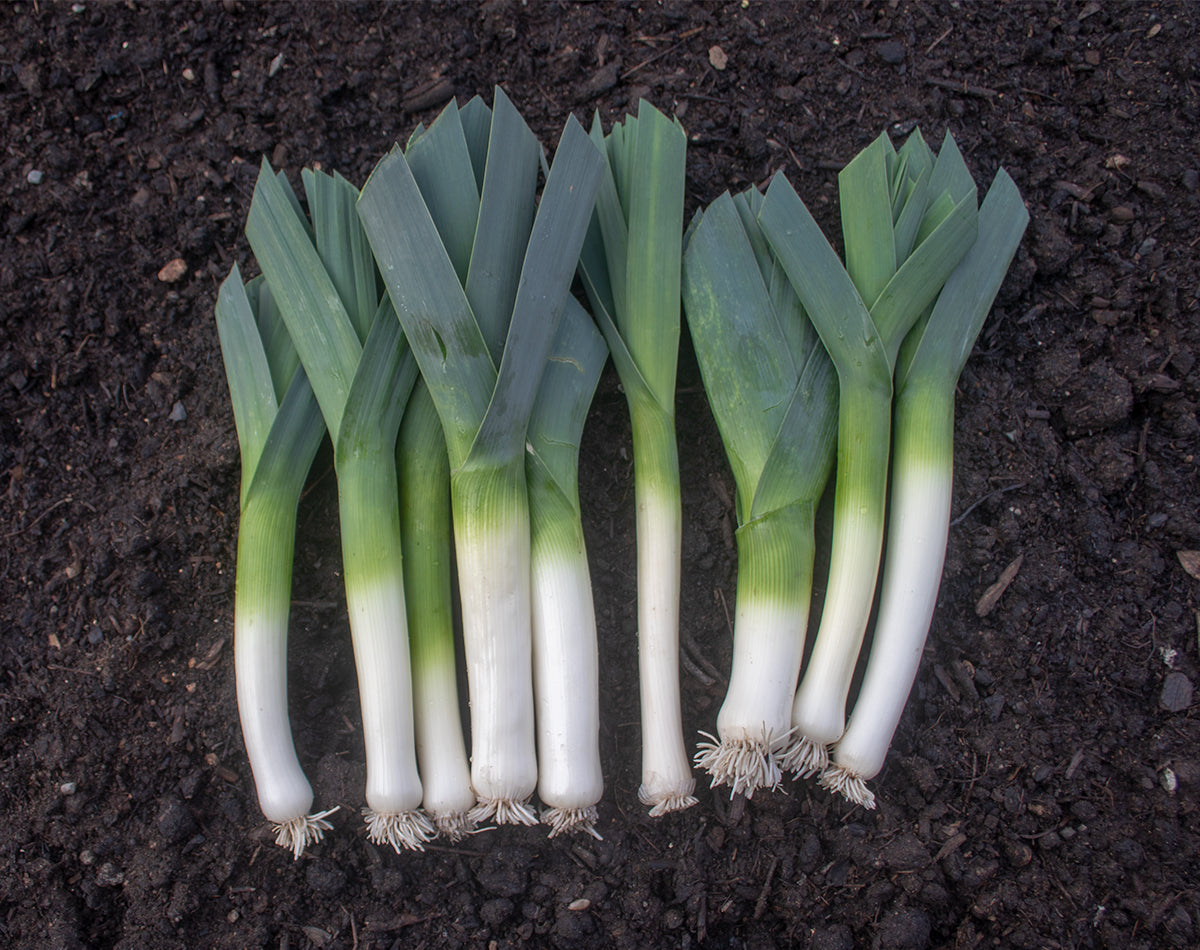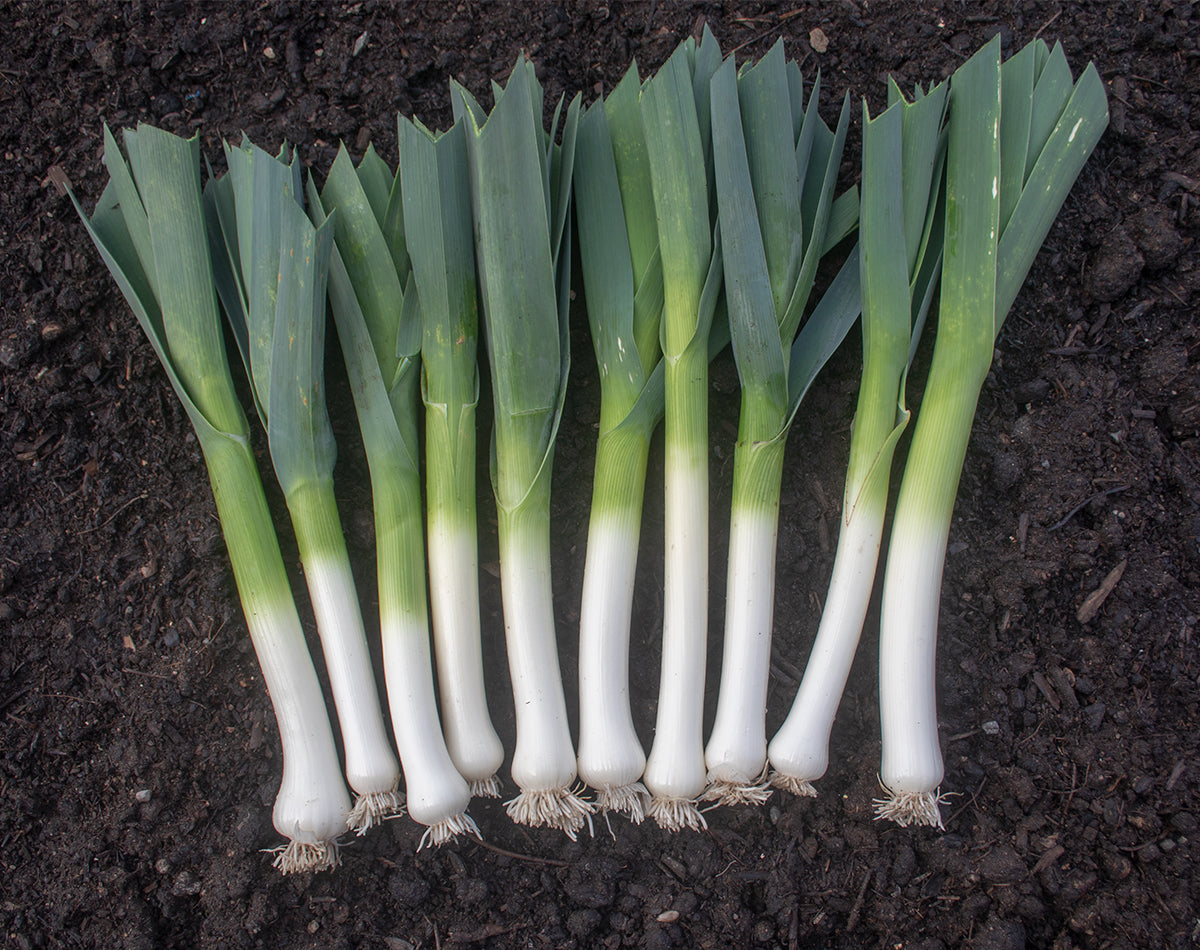Last summer I planted a few rows of fall and winter harvest leeks in our demonstration beds at Kirkland House here in Ladner. We chose the varieties described as “winter harvest” since they are bred to stand up to frost, but included Alto Varna, which is known mostly as a fast growing summer harvest leek.
All these leeks were sown last July, and transplanted into five inch holes in early September. While they are intended for harvest between November and February, they lasted in very good form until late April.
While we did harvest a few leeks over winter, the season sped around with alarming quickness. I found myself wanting to plant sunflower seeds in beds that were still clogged with leeks. So we harvested the leeks yesterday, and this is what I can report on overwintered leeks.
 Bandit Organic is a tough little plant. It’s not the most uniform leek in the trial, but it simply shrugged off the worst winter weather. From one sowing (shown above), the shank (white part) varies quite a lot. The distance from root to leaves is also variable, as is the thickness, and there is little or no bulb formation at the base. But the flavour is amazing. I would recommend this leek for harvest in cold areas, down to Zone 4 or 5. For fall harvest, I think it could take Zone 3. We are spoiled by mild winters here in Zone 8, but still – it has been a long period of cold and damp. Bandit survived unscathed.
Bandit Organic is a tough little plant. It’s not the most uniform leek in the trial, but it simply shrugged off the worst winter weather. From one sowing (shown above), the shank (white part) varies quite a lot. The distance from root to leaves is also variable, as is the thickness, and there is little or no bulb formation at the base. But the flavour is amazing. I would recommend this leek for harvest in cold areas, down to Zone 4 or 5. For fall harvest, I think it could take Zone 3. We are spoiled by mild winters here in Zone 8, but still – it has been a long period of cold and damp. Bandit survived unscathed.
 In the very next row grew Tadorna Organic. The uniformity is clearly improved in this leek, as is the shank length. There is slight bulbing at the base, but the consistency is pretty impressive. Again, this leek has a nice, medium-strong flavour… That onion-like, savoury quality without the onion heat. This is the perfect leek for making winter soups and omelettes. I think with some straw mulch, these might make it through a Zone 3 winter.
In the very next row grew Tadorna Organic. The uniformity is clearly improved in this leek, as is the shank length. There is slight bulbing at the base, but the consistency is pretty impressive. Again, this leek has a nice, medium-strong flavour… That onion-like, savoury quality without the onion heat. This is the perfect leek for making winter soups and omelettes. I think with some straw mulch, these might make it through a Zone 3 winter.
 The real surprise came from Alto Varna Organic leeks. Mature at 60-80 days, these fellows lasted an astonishing 200 days! And they’re in good eating shape, too. They slice nicely, with a crisp texture that is tender, not stringy. The flavour is refined and delicate – but look at those stems! The blanched shank could have been longer if we hilled soil up around the stems as they grew, which I plant to do this season. Still, the portion of usable stem is nearly twelve inches long. I cannot complain about uniformity in these “accidental” participants in the trial, since they are not meant to be planted this way. While Bandit and Tadorna get those blue-green leaves that are tough as leather, Alto Varna is green the whole way up. I think I have a new favourite leek.
The real surprise came from Alto Varna Organic leeks. Mature at 60-80 days, these fellows lasted an astonishing 200 days! And they’re in good eating shape, too. They slice nicely, with a crisp texture that is tender, not stringy. The flavour is refined and delicate – but look at those stems! The blanched shank could have been longer if we hilled soil up around the stems as they grew, which I plant to do this season. Still, the portion of usable stem is nearly twelve inches long. I cannot complain about uniformity in these “accidental” participants in the trial, since they are not meant to be planted this way. While Bandit and Tadorna get those blue-green leaves that are tough as leather, Alto Varna is green the whole way up. I think I have a new favourite leek.



